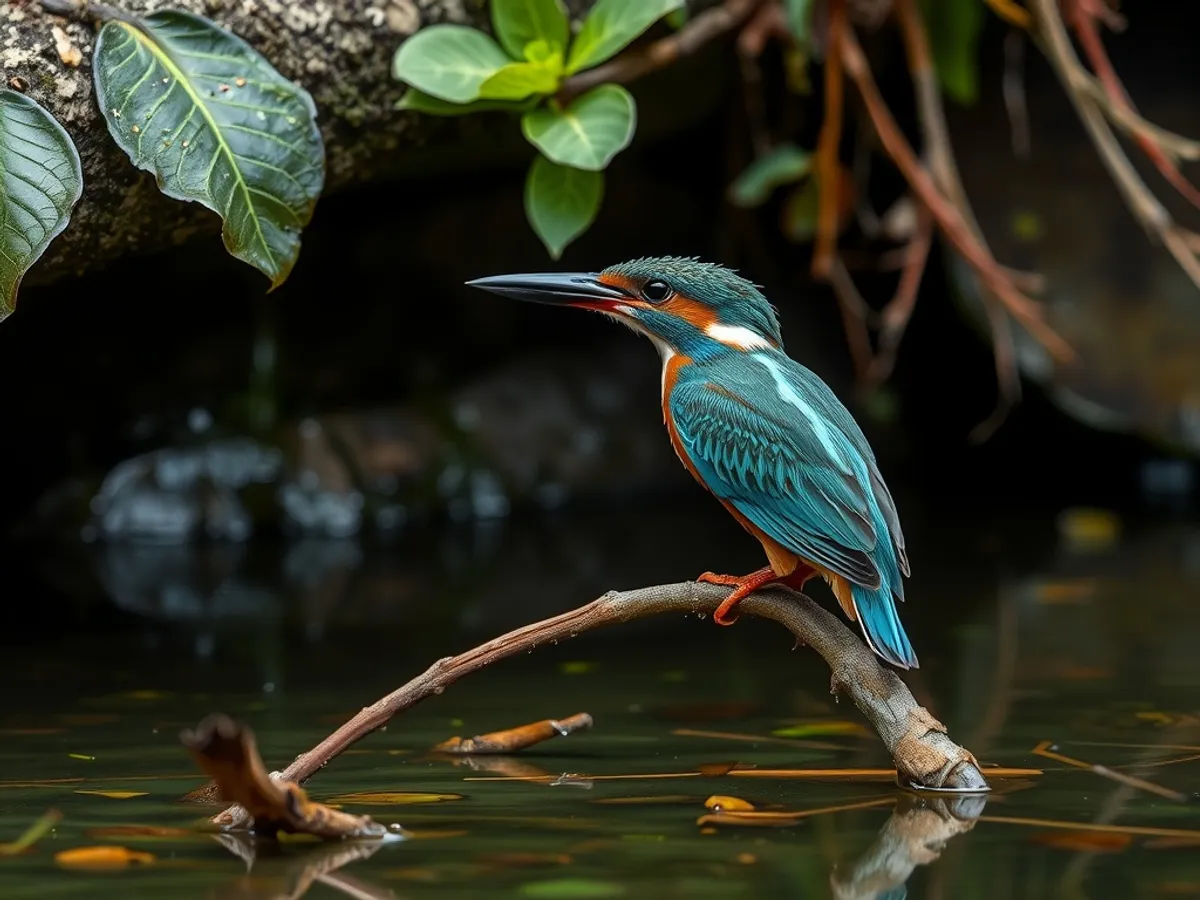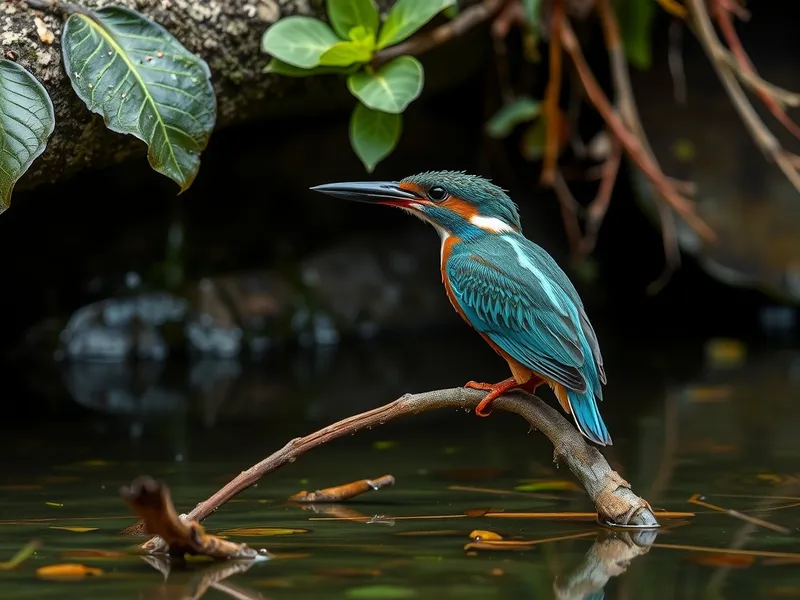
Eurasian Kingfisher
Alcedo atthis

Meet the Eurasian Kingfisher
The Eurasian Kingfisher is a small, brightly colored bird known for its dazzling blue and orange plumage and its rapid, darting flight over rivers and streams. It is widely distributed across Europe, North Africa, and Asia, typically inhabiting freshwater habitats with clean, slow-moving water. This bird is a skilled hunter, using its sharp vision to spot fish and aquatic insects before plunging headfirst to catch its prey. The Eurasian Kingfisher is often seen perched quietly on a branch, scanning the water below. Despite its vivid appearance, it can be surprisingly difficult to spot due to its shy and elusive nature.
Classification
Bird
Habitat
Freshwater rivers, streams, lakes, and ponds with overhanging vegetation
Diet
Carnivore
Lifespan
2-4 years
Conservation
Least Concern
Weight
34–46 g
📖Fascinating Facts
Expert Fisher
Eurasian Kingfishers can catch and eat up to 60% of their body weight in fish each day, often diving multiple times to secure a meal.
Specialized Habitat
They require clear, unpolluted freshwater with abundant small fish and vertical riverbanks for nesting tunnels.
Underwater Vision
Their eyes have two foveae and special oil droplets that allow them to judge distances accurately underwater and compensate for refraction.
📋Detailed Description
The Eurasian Kingfisher (Alcedo atthis) is a compact, vibrantly colored bird measuring 16–17 cm in length with a wingspan of 24–26 cm and weighing 34–46 grams. Its plumage is striking, with iridescent azure-blue upperparts and rich orange underparts, while the bill is long, straight, and dagger-like—black in males and with a reddish base in females. The head is large relative to its body, with a short tail and small, rounded wings adapted for rapid, direct flight. The kingfisher’s eyes are positioned for binocular vision, aiding precise depth perception during hunting. Primarily solitary outside the breeding season, it maintains and defends linear territories along watercourses. Its call is a sharp, high-pitched whistle, often heard before the bird is seen. The Eurasian Kingfisher is highly territorial, with individuals patrolling stretches of riverbank up to 1 km in length. It is diurnal, most active at dawn and dusk when prey is abundant. The species excavates nesting tunnels in vertical riverbanks, demonstrating remarkable digging ability. Its lifespan in the wild is typically 2 years, though individuals may live longer under favorable conditions.
💡 Did you know?
Despite being brightly colored, Eurasian Kingfishers are often heard before they are seen, thanks to their high-pitched, whistling call.
🔬Research & Sources
Wikipedia Summary
The common kingfisher, also known as the Eurasian kingfisher and river kingfisher, is a small kingfisher with seven subspecies recognized within its wide distribution across Eurasia and North Africa. It is resident in much of its range, but migrates from areas where rivers freeze in winter.
Last Modified: 11/16/2024
🎭Behavior & Social Structure
Eurasian Kingfishers are visual hunters, perching silently above water to scan for prey, primarily small fish such as minnows and sticklebacks, but also aquatic insects, crustaceans, and occasionally amphibians. Hunting involves a characteristic plunge-dive, with the bird folding its wings and entering the water bill-first to seize prey. After catching prey, the kingfisher returns to its perch to stun and manipulate the catch before swallowing it head-first. They are highly territorial, with aggressive displays and chases used to deter intruders. Social interactions are limited outside the breeding season, with pairs forming only during courtship and nesting. Daily routines include frequent preening to maintain waterproofing of the plumage, sunbathing, and regular feeding bouts interspersed with periods of rest. Kingfishers are sensitive to disturbance and water quality, often abandoning territories if prey becomes scarce or habitat is degraded.
👶Reproduction & Life Cycle
Breeding occurs from March to August, with timing varying by latitude. Courtship involves aerial chases and the male presenting fish to the female. Both sexes excavate a horizontal tunnel, 60–90 cm long, in a vertical riverbank, ending in a nesting chamber. The female lays 5–7 glossy white eggs, which are incubated by both parents for 19–21 days. Chicks are altricial, hatching blind and naked, and are fed regurgitated fish by both parents. Fledging occurs after 23–27 days, but young remain dependent for up to four days post-fledging. Multiple broods (up to three per season) are common in favorable conditions. High chick mortality is typical, often due to flooding, predation, or food shortages.
🛡️Adaptations & Survival
The Eurasian Kingfisher exhibits several adaptations for its aquatic lifestyle. Its eyes possess a high density of cone cells for acute vision and can compensate for light refraction underwater by rapidly adjusting focus. The nictitating membrane protects the eyes during dives. The bill is specialized for spearing and grasping slippery prey. Dense, waterproof plumage and a streamlined body reduce drag in water. Short legs and syndactylous (fused) toes facilitate perching and burrow excavation. Behavioral adaptations include territoriality to ensure sufficient food supply and the ability to relocate quickly if habitat conditions deteriorate.
🎨Cultural Significance
The Eurasian Kingfisher has long held symbolic meaning in various cultures, often representing peace, prosperity, and good fortune. In Greek mythology, the bird is associated with the story of Alcyone and Ceyx, giving rise to the term 'halcyon days.' Its vivid plumage has inspired art and literature, and it is a favored subject in European folklore. In some regions, kingfisher feathers were historically used in ornamental crafts, though such practices are now rare and discouraged.
🔬Recent Research & Discoveries
Recent research has focused on the kingfisher’s visual adaptations, particularly its ability to judge refraction and target prey underwater. Studies using high-speed videography have detailed the biomechanics of its plunge-diving behavior. Ongoing conservation research monitors population trends in response to water quality and habitat restoration. Genetic studies have clarified the relationships among the seven recognized subspecies, revealing subtle adaptations to local environments. Citizen science projects, such as nest monitoring, contribute valuable data on breeding success and habitat use.
🎥Wildlife Videos

Kingfisher - The Hunt for Germany's Flying Diamond | Free Documentary Nature
Kingfisher - The Hunt for the Flying Diamond | Free Nature Documentary This is the story of an animal filmmaker who fulfilled a ...
Free Documentary - Nature

Kingfishers - The Gift of Nature (flying rainbow) | Go Wild
The Oriental Dwarf Kingfisher is one of the most enigmatic and rarely filmed birds in the world. This fascinating documentary ...
Go Wild

Common Kingfisher. Bird catching a fish. David Attenborough's opinion.
This is a clip from "RHYTHMS OF NATURE IN THE BARYCZ VALLEY" movie. If you like this clip, you can watch the full movie ...
Artur Homan

Filming Kingfisher | 4k Wildlife Documentary 2022
Kingfishers are predatory birds that range from 10 to 42cm in length. They have a large head, a long and massive bill, and a ...
unlimiteDesign

Common Kingfisher | Wildlife documentary | Wildlife Photography | Animal videos documentary
wildlife #birds #wildlife he common kingfisher, also known as the Eurasian kingfisher, is a small, brightly colored bird found across ...
Divine Wildlife

The kingfisher - Germany's flying diamond
This is the story of an animal filmmaker who fulfilled a childhood dream: a documentary, featuring the reclusive and rare kingfisher ...
Free High-Quality Documentaries
🌍Habitat Information
The Eurasian Kingfisher typically inhabits Freshwater rivers, streams, lakes, and ponds with overhanging vegetation environments. Eurasian Kingfishers have adapted to their environments with specialized features and behaviors.
Primary Habitat:
Freshwater rivers, streams, lakes, and ponds with overhanging vegetation
More detailed habitat information will be available soon.
🛡️Conservation Status
The Eurasian Kingfisher is currently classified as Least Concern. Conservation efforts are crucial for preserving this species for future generations.
Common Threats:
- 🏠Habitat loss and fragmentation
- 🌡️Climate change impacts
- 🎯Hunting and poaching
- 🏭Human-wildlife conflict
⚠️Threats & Conservation Challenges
While currently listed as Least Concern by the IUCN, the Eurasian Kingfisher faces threats from habitat loss, water pollution, riverbank modification, and disturbance from human activity. Pesticide runoff and siltation reduce prey availability, while cold winters and flooding can cause significant mortality. In some regions, population declines have been observed due to intensive river management and urbanization. Conservation efforts focus on maintaining clean, undisturbed waterways with natural banks and abundant fish populations.
🔬Scientific Classification
Scientific Name
Alcedo atthis
Classification Hierarchy
🔍 About Taxonomic Classification
Taxonomic classification is a hierarchical system used by scientists to classify and organize living organisms based on shared characteristics and evolutionary relationships.
The system moves from broad categories (Kingdom) to increasingly specific ones, with each animal's scientific name typically consisting of its Genus and species.
📝Community Notes
Share your observations and insights about the Eurasian Kingfisher with our community of wildlife enthusiasts.
Join Our Community
Sign in to share your observations and connect with fellow wildlife enthusiasts.
Sign In to ContributeNo community notes yet
Be the first to share your observations about the Eurasian Kingfisher!
Explore Eurasian Kingfisher
Select a tab above to learn more about this amazing animal.
📸Photo Gallery
No photos available for this animal yet.
🌟Discover More Wildlife
Continue your journey of discovery with more fascinating animals from our database
